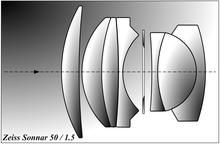Cementing

Cementing means that two or more lenses of an optical system are connected to one another by gluing their neighboring surfaces, which must have the same radii, together with a thin, transparent layer of cement. In the past, Canada balsam was used for this , now mostly synthetic resin .
Putty is useful if the construction of the system shows that the adjacent surfaces of two lenses have similar radii and a small distance from one another. Then the properties of the system are usually not changed significantly by the cementing of these surfaces, ie the imaging errors can be corrected almost as well with the cemented surfaces.
The cementing is done to reduce manufacturing costs. The cemented surfaces do not have to be remunerated because less light is reflected on the glass- cemented surfaces due to the smaller refractive index difference . In addition, the construction of the socket and the assembly process are simplified when fewer groups are to be assembled. A group refers to two or more lenses cemented to one another and a single, non-cemented lens.
It is also cemented to prevent total reflection from a glass-air surface. If the lens in question is cemented to the next one, the difference in the refractive index on the surface decreases and the rays can hit the surface with a greater angle of incidence.
In the past, cement was also used to reduce the effects of reflection on the glass-air surfaces by reducing their number. A cemented surface reduces the amount of reflection, but still provides degrees of freedom for correcting the aberrations . Earlier lens designs therefore often had a large number of cemented surfaces, such as the Sonnar pictured with seven lenses in three groups. There were even designs with ten lenses in two groups. Today this is no longer a criterion, as there are high-quality remuneration methods that reduce reflection just as well.
The wringing is a similar technique to connect two lenses. In this case, no cement is used, but the lenses adhere by adhesion directly to each other. The advantage is the greater precision, since you actually only have one surface, and not two, which limit the cement layer of not exactly defined thickness. However, it is disadvantageous that the surfaces that are blasted on have to be worked very precisely, and after the blasting the mutual position of the lenses can no longer be corrected. Lenses that have been cemented can be shifted against each other as long as the cement has not hardened.
